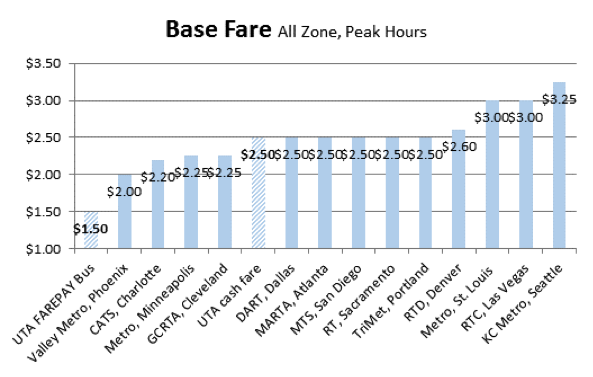How do UTA fares compare to other transit agencies? There was a misleading article posted by The Salt Lake Tribune calling UTA’s system among the most unaffordable in the country. The article used a blog for its information, not a scientific study, and the links to the supporting data were broken.
In short, calling UTA’s system among the most unaffordable in the country is simply untrue.
UTA’s $2.50 one-way cash bus fare is comparable to other mid-size transit agencies in Dallas, Atlanta and San Diego. But, when you take into consideration the 40 percent discount riders receive with FAREPAY, bus fare drops to just $1.50, lower than many other agencies nationwide.

FAREPAY is UTA’s electronic fare payment card. It is available to all riders and provides a 40 percent discount on bus fare, 20 percent off TRAX and S-Line fare, and up to 20 percent off FrontRunner fare.
The Tribune’s article also questioned the agency’s commitment to promoting its FAREPAY product. FAREPAY has been widely advertised through several paid campaigns, with the most recent taking place this past March and April. UTA has also displayed FAREPAY promotional materials at its rail stations and inside its buses for the last three years and has used less traditional forms of promotion including unique point-of-sale displays and regional giveaways.
FAREPAY is just one of the ways that riders can receive discounted fare. UTA also offers monthly passes to help riders reduce transit costs. We partner with schools and businesses across the Wasatch Front to offer passes at a reduced price. Kids and teens can ride UTA all summer for just $75 using a Rider’s License pass. We also provide reduced fare to riders who meet eligibility requirements. All told, between 75 and 80 percent of our riders use FAREPAY, passes or other forms of reduced-fare payment when riding.
Other unique UTA rider benefits include the Free Fare Zone and free transfers. The Free Fare Zone allows riders to ride TRAX and buses free in the heart of downtown Salt Lake City. Riders can also transfer to another bus or TRAX line at no additional charge within two hours of purchasing their ticket or tapping on with a pass. Riders with an active transfer can deduct the cost of their bus or TRAX fare from their FrontRunner ticket.
In addition to its efforts in keeping fares affordable, UTA is looking at other ways to improve its fare structure. We recently completed a year-long analysis that was one of the most comprehensive studies in the agency’s history. The analysis included one-on-one interviews, on board surveys, online surveys, a phone survey across the Wasatch Front, and multiple focus groups with riders and non-riders. We consistently heard that people wanted fares to be simple, predictable and easy to understand. The majority of riders polled believed that fares were appropriate for the value received. UTA is currently preparing a proposal for a future fare structure in response to this feedback and will take the proposal to the public for review and comment.
UTA would like to thank all riders for their support. Although UTA has not had a fare increase since 2013 and has actually lowered fares with the launch of FAREPAY, fares currently cover 22 percent of operations costs. This allows us to maintain and upgrade equipment, expand service and provide public transportation to thousands of riders across the Wasatch Front each year, while equitably balancing the cost the rider is paying with the taxpayer subsidy.
